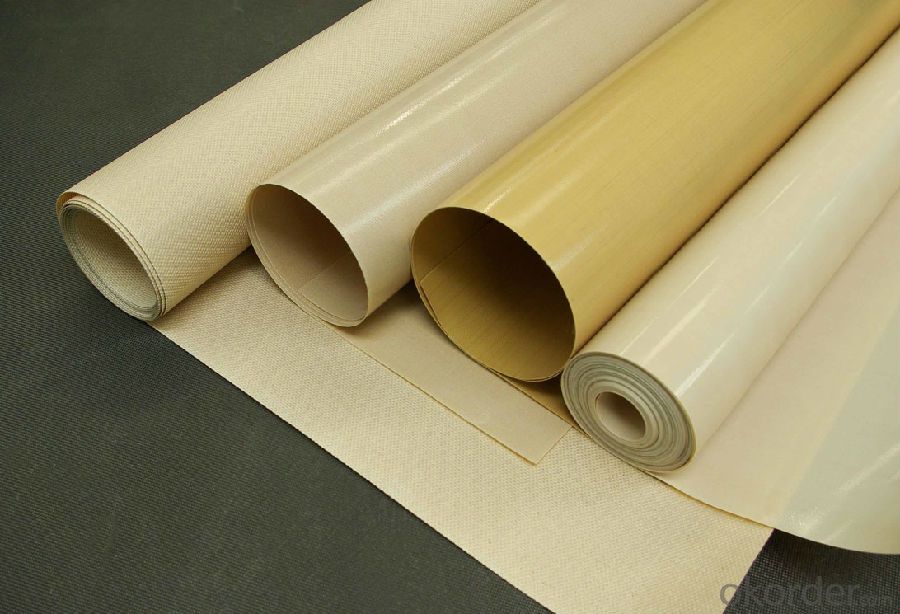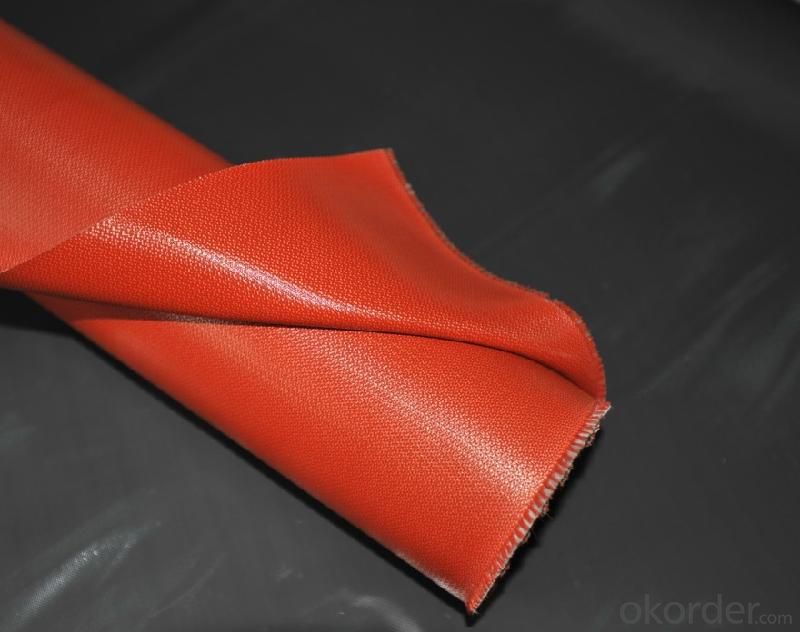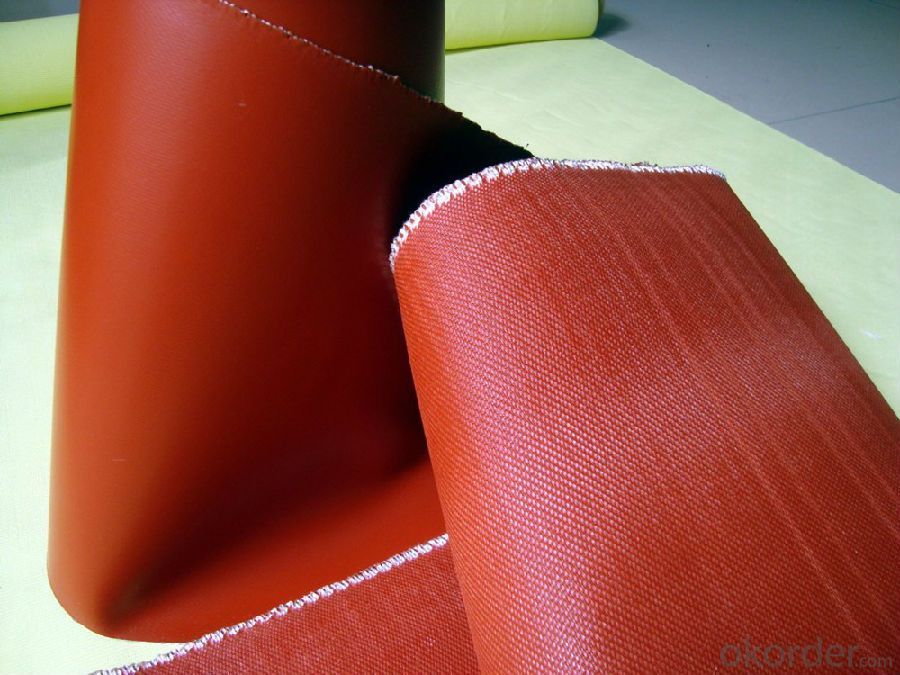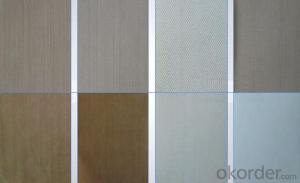Silicone Coated Fiberglass Fabric of Different Colors
- Loading Port:
- Shanghai
- Payment Terms:
- TT OR LC
- Min Order Qty:
- 500 m²
- Supply Capability:
- 50000 m²/month
OKorder Service Pledge
OKorder Financial Service
You Might Also Like
Silicone Coated Fiberglass Fabric of Different Colors
Fiberglass Fabric Description
Silicone coated fiberglass fabric is a fiberglass cloth, which possesses the properties of temperature resistance, anti-corrosion, high strength and is coated with organic silicone rubber.
Fiberglass Fabric Specification
Thickness:0.2mm-5mm
Width:100cm-150cm
Color;grey/red/silver/black
Weight(coating):130gsm-2800gsm
Model No | FSD2030 | FSD2030 | FSD2050 | FSD2100 | |
High temperature resistant(°C) | ≤280 | ≤280 | ≤280 | ≤280 | |
Low temperature resistant(°C) | ≥-40 | ≥-40 | ≥-40 | ≥-40 | |
Tensile intensity (N/50mm) | Warp | ≥1750 | ≥1750 | ≥2500 | ≥3500 |
Weft | ≥1280 | ≥1280 | ≥2100 | ≥3000 | |
Inflating burst intensity(Mpa) | ≥2.0 | ≥2.0 | ≥2.2 | ≥2.6 | |
Peeling intensity(N/m) | ≥450 | ≥450 | ≥520 | ≥600 | |
Insulation (kv/mm) | 16 | 16 | 18 | 18 | |
Weight (g/m*m) | 550-650 | 550-650 | 750-800 | 1500-1800 | |
Width(mm) | 1000±20 | 1000±20 | 1000±20 | 1000±20 | |
Thickness(mm) | 0.3-0.4 | 0.3-0.4 | 0.05-0.55 | 1.0-1.1 | |
color | Silver-gray, gray, red | lucency | Silver-gray, gray, red | Black, gray, red | |
Fiberglass Fabric Features:
1, Good performance on resisting high temperature and low temperature, -40°C-280°C;
2, High strength;
3, Ozone, oxide, light and weather aging resistance;
4, High insulation: dielectric constant:3-3.2, breakdown voltage: 20-50KV/MM;
5, Chemical corrosion resistant, oil-proofing, waterproofing (washable)
Fiberglass Fabric Application:
It has been widely used in construction, electric insulation,
chemical industry, pipeline ductile conjunction, large generating
Corrosion proofing field, machinery, metallurgy, sealing and so on.
Product Show



FAQ
1.What are the characteristics of fiberglass fabric?
a)Outstanding temperature resistance(from -70°C to +260°C)
b)Excellent chemical resistance
c)Superior non-stick surface, easy to clean
d)High dielectric strength
e)Dimensional stability
f)Resistance to UV, IR and HF
g)Non-toxic
2.How many methods to weave the fabric?
Four methods to weave the fabric:
a).Plain weave: it can be used in electricity insulation materials and reinforced materials in industry, because of inseparable structure, plain and clear lines.
b).Twill weave: compared with plain weave, it is of high density, high intensity, with a soft and loose structural weave. It can be used in ordinary reinforced materials, filter materials, and painting cloth.
c) Satin weave: compared with plain weave and twill weave, it is of high density,high intensity, with a soft and loose structural weave with a good texture. It is applicable for use as a higher reinforced material in machinery.
d).Gauze weave: said lattice twist weave. It can be used in spread model curtain,resin reinforced emery wheel gray cloth and lattice embed belt.
3.Can you offer us some samples?
We are willing to offer our customers best product&service,if it's necessary we can send
you sample for test;also we welcome all you customer have a trial order.
- Q:Is fiberglass fabric resistant to moisture penetration?
- Indeed, fiberglass fabric exhibits a remarkable resistance to the penetration of moisture. Crafted from delicate glass strands interwoven to form an enduring and robust textile, fiberglass possesses inherent properties that render it impervious to water. Its inability to absorb or facilitate the passage of water renders fiberglass fabric an optimal choice for endeavors necessitating moisture resistance, including the creation of boat covers, outdoor furniture, and protective garments. Moreover, owing to its capacity to withstand moisture infiltration, fiberglass fabric frequently finds application in locales prone to high humidity or frequent water exposure, such as bathrooms and swimming pools.
- Q:Is fiberglass fabric resistant to chemicals in water treatment facilities?
- Yes, fiberglass fabric is generally resistant to chemicals in water treatment facilities. It has excellent resistance to a wide range of chemicals, including acids, alkalis, and solvents, making it a suitable choice for various applications in water treatment facilities.
- Q:What are the different surface textures available in fiberglass fabric?
- Fiberglass fabric is known for its versatility and wide range of surface textures, each offering unique properties and benefits. Some of the different surface textures available in fiberglass fabric include: 1. Plain Weave: This is the most basic and commonly used texture, featuring a simple over-and-under pattern of fibers. It offers good strength and stability while providing a smooth surface finish. 2. Twill Weave: Twill weave consists of a diagonal pattern created by interlacing fibers. It offers improved drapability, better conformability, and increased strength compared to plain weave. Twill weave also provides a distinctive appearance. 3. Satin Weave: Satin weave involves floating yarns over multiple warp or weft yarns, resulting in a smooth and lustrous surface. It offers excellent flexibility, durability, and a high-quality finish. Satin weave is commonly used in applications requiring a high level of aesthetics. 4. Leno Weave: Leno weave is characterized by a pair of warp yarns twisting around weft yarns, creating an open mesh structure. This texture enhances breathability, allows easy resin saturation, and provides good drapability. Leno weave is often utilized in applications where air circulation or filtration is crucial. 5. Jacquard Weave: Jacquard weave involves complex patterns created by individual control of each warp yarn. It allows intricate designs and textures to be woven into the fabric. Jacquard weave is commonly used for decorative purposes or when specific patterns are required. Each surface texture in fiberglass fabric is designed to cater to specific applications, such as aerospace, automotive, marine, construction, and industrial sectors. The choice of texture depends on factors such as the desired strength, flexibility, aesthetics, and functionality required for the particular application.
- Q:Can fiberglass fabrics be custom-designed or printed on?
- Yes, fiberglass fabrics can be custom-designed or printed on. Fiberglass fabrics are versatile and can be easily manipulated to suit specific design requirements. The printing process involves applying a design or pattern onto the fabric using various techniques such as screen printing, digital printing, or transfer printing. This allows for endless possibilities in terms of customization, including the incorporation of logos, images, or unique designs. Custom-designed or printed fiberglass fabrics are commonly used in industries such as fashion, interior design, automotive, and aerospace, where aesthetic appeal and branding are important factors.
- Q:How does fiberglass fabric handle moisture?
- Fiberglass fabric has excellent resistance to moisture and is considered to be highly water-resistant. Due to its composition of woven glass fibers, it does not absorb water and is unaffected by moisture or humidity. This makes fiberglass fabric ideal for applications where exposure to moisture is expected, such as boat hulls, outdoor furniture, and building materials. Additionally, fiberglass fabric does not promote the growth of mold or mildew, further enhancing its ability to handle moisture.
- Q:Can fiberglass fabric be used for reinforcement in 3D printing?
- Yes, fiberglass fabric can be used for reinforcement in 3D printing. Fiberglass fabric is a strong and lightweight material that can provide additional structural support to 3D printed objects. It can be used to reinforce certain areas of a print, such as corners or joints, to prevent cracking or breaking. By adding layers of fiberglass fabric within the 3D printed object, the overall strength and durability can be significantly improved. However, it is important to note that using fiberglass fabric in 3D printing may require specialized equipment and techniques to ensure proper adhesion and integration with the printed material.
- Q:Rural cement flat roof room, how to do waterproof, anti leakage best?
- The laying of the rigid waterproof layer, should be completed in the first flexible waterproof layer after two days of construction, mainly in high fatty acid waterproofing agent, cement mortar, sand, fine aggregate, fiber as basic material, waterproof layer thickness is 20-30 mm;(1) install the grid batten according to the specification, and set it to 4000 millimeters * 4000 millimeters. Then sprinkle water to make the base surface moist, but no water;According to (2), from far to near, from high to low order, the mortar prepared fine stone concrete or by grid construction, with a lattice a complete, smooth compaction;(3) after the initial setting, remove the partition bar, press and trim the partition joint;(4), using the flexible sealing material filling dividing joint, surface treatment. After completion of construction, pay attention to sprinkler maintenance;(5) if there is roof planting soil, it should be covered with planting soil in as short as possible time.
- Q:Is fiberglass fabric resistant to aging or deterioration?
- Yes, fiberglass fabric is highly resistant to aging and deterioration. Its durable nature allows it to maintain its strength and structural integrity over time, making it a reliable option for various applications.
- Q:What are the different colors available for fiberglass fabric?
- Fiberglass fabric is available in a wide range of colors to suit different preferences and applications. The most common colors include white, black, gray, and beige. These neutral colors are often used in industrial and commercial settings where aesthetics may not be a priority. However, fiberglass fabric is also available in vibrant colors such as red, blue, green, and yellow, which are commonly used in architectural and design applications. Additionally, custom colors can be created by dyeing the fabric to meet specific requirements. The availability of different colors allows for flexibility in design and ensures that fiberglass fabric can be seamlessly integrated into various projects.
- Q:Can fiberglass fabric be used for insulation in aerospace applications?
- Yes, fiberglass fabric can be used for insulation in aerospace applications. It is a common choice due to its excellent thermal resistance, lightweight nature, and resistance to high temperatures. Additionally, fiberglass fabric provides good sound insulation, making it suitable for aerospace environments.
1. Manufacturer Overview |
|
|---|---|
| Location | |
| Year Established | |
| Annual Output Value | |
| Main Markets | |
| Company Certifications | |
2. Manufacturer Certificates |
|
|---|---|
| a) Certification Name | |
| Range | |
| Reference | |
| Validity Period | |
3. Manufacturer Capability |
|
|---|---|
| a)Trade Capacity | |
| Nearest Port | |
| Export Percentage | |
| No.of Employees in Trade Department | |
| Language Spoken: | |
| b)Factory Information | |
| Factory Size: | |
| No. of Production Lines | |
| Contract Manufacturing | |
| Product Price Range | |
Send your message to us
Silicone Coated Fiberglass Fabric of Different Colors
- Loading Port:
- Shanghai
- Payment Terms:
- TT OR LC
- Min Order Qty:
- 500 m²
- Supply Capability:
- 50000 m²/month
OKorder Service Pledge
OKorder Financial Service
Similar products
New products
Hot products
Related keywords



























